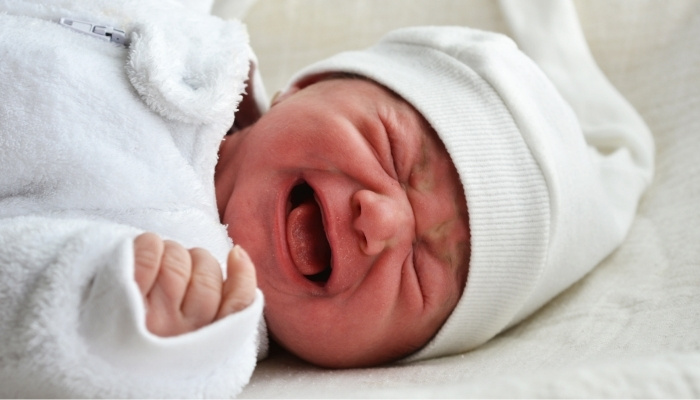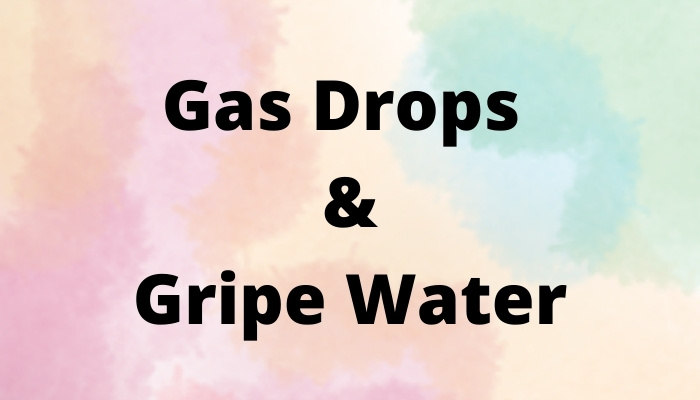Gas drops primarily contain simethicone while gripe water typically contains sodium bicarbonate and herbal extracts as its main components.
There is no evidence that using these together can cause reactions, but it’s best to consult your child’s pediatrician both for the individual and combined use of these products.
A word of caution from Poison Control:
“In the U.S. (unlike in Europe), botanical preparations and dietary supplements are not regulated by the government.
There is no assurance that products with the same label actually contain the same ingredients in the same amounts.”
I only used gas drops with my children, but I know of other women who often used both gas drops and gripe water with no ill effects.
Although using gas drops and gripe water together will not likely cause harm, it’s probably best to err on the side of caution by sticking to gas drops, which are regulated and deemed safe for infants.
Table of Contents
Using Gas Drops and Gripe Water Together
First and foremost, it’s best to consult with your child’s pediatrician when using these substances either individually or in combination.
The largest concern with mixing products is the chance of a chemical reaction between ingredients or an allergic reaction in the child.
There is no evidence that mixing the key ingredients of gas drops (simethicone) and gripe water (sodium bicarbonate and herbal oils) causes any sort of reaction.
This means that this is safe until proven otherwise.
However, both manufacturers and pediatricians seem to agree that mixing these two has the potential to do more harm than good.
Gas Drops vs. Gripe Water
Users on both sides rave about the efficacy and safety of their favorite gas relief methods, but there is vital information to be understood prior to making a decision — everything from the way they’re formulated to the evidence supporting their safety.
| Gas Drops | Gripe Water |
|---|---|
| Regulated by the FDA | Not regulated |
| Contains simethicone | Ingredients can vary |
| Only addresses gas | Might address upset tummy, fussiness, or hiccups as well |
| Considered safe | Varied safety concerns |
| Ingredients are not absorbed by baby’s system | Ingredients are absorbed by baby’s system |
How To Tell if a Baby Has Colic or Gas
Approximately 20% of babies develop colic.
A baby with colic is defined as one who cries 3 or more hours a day, 3 days out of the week, for 3 consecutive weeks and is otherwise a healthy infant.
Colic is marked by continuous inconsolable crying, reduced appetite, changes in sleep, and intense gas.
Children who display similar symptoms but don’t follow the 3/3/3 pattern most likely have gas rather than colic.
Gas occurs in almost all infants in varying severities.
Gas is caused by an excess intake of air while eating or crying, hypersensitivity to certain foods or allergens, and an underdeveloped digestive system.
Gassy babies tend to show signs of discomfort like squirming, fussiness, trouble sleeping, not eating, and pulling their legs up to their chest.
Gas tends to come and go in bouts as it flares up and then resolves itself regularly.
| Gas Symptoms | Colic Symptoms |
|---|---|
| Fussiness or crying after feeding | Intense, inconsolable crying, often in the late afternoon or evening |
| Frequent spit-up, burping, or flatulence | Reduced appetite |
| Legs pulled up to chest | Clenching fists and arching back during episodes |
| Passing gas brings relief | Not easily relieved |
| Difficulty sleeping | Changes in sleep patterns/durations |
| Bloated or hard belly | Also shows signs of gas |
Gas Relief Drops for Babies
Gas drops are an FDA-regulated medicine. This means that gas drops are tested for safety and quality at a federal level.
The active ingredient in gas drops is simethicone, which relieves pressure and symptoms caused by excess gas.
Simethicone works by breaking up gas bubbles in the body. However, studies question the efficacy of gas relief drops.
Uses
Gas relief drops claim to relieve symptoms of pressure and discomfort from excess gas in infants.
When To Give Gas Drops
According to manufacturers, gas relief drops are safe for even the youngest of newborns.
You can administer gas drops when your child starts displaying symptoms of discomfort related to excess gas.
This typically occurs after a feeding or lying down overnight.
It’s best to consult with a pediatrician about the right time to give your child gas drops.
Gas Drops Before or After a Feeding
Gas drops can be given both before and after a feeding.
Since gas drops claim to improve the natural process of gas expulsion, some parents choose to administer them beforehand so that the simethicone can work its magic during digestion.
Others choose to wait until after a feeding session in case the baby takes in excessive quantities of air while eating.
How Long Gas Drops Take to Work
Gas relief drops are not scientifically backed. In fact, the research shows that gas drops may not be as effective in relieving gas as touted.
Even the anecdotal evidence varies from case to case.
However, manufacturers and parents claim that they begin to alleviate symptoms within 10 minutes.
Most gas relief drops can be administered up to 12 times per day, but always check the label and consult a pediatrician for dosing instructions.

Gripe Water for Babies
Gripe water is considered a dietary herbal supplement, so it is not regulated by the FDA.
This means it does not have to meet the same quality requirements that gas drops do.
The active ingredients in most gripe waters are herbal oils like dill weed and fennel alongside sodium bicarbonate.
Manufacturers claim that gripe water works similarly to gas drops, but there is no clinical evidence supporting this.
Uses
Gripe water claims to relieve the symptoms of excess gas, colic, and hiccups.
When To Give Gripe Water
According to manufacturers, gripe water is safe for children ages 1 month and up.
You can administer gripe water when a child displays symptoms of discomfort due to excess gas or continuous crying associated with colic or if the child has hiccups.
It’s best to consult with a pediatrician about the right time to give your child gripe water.
Gripe Water Before or After a Feeding
There are no specific instructions on when to administer gripe water. It can be done both before and after a feeding.
Most often, giving gripe water is done after to address any excess gas taken in while eating.
However, it’s recommended to wait at least 30 minutes after eating to give a baby gripe water so that food can digest properly.
Otherwise, the gripe water may mix poorly with other contents of the stomach and cause vomiting.
How Long Gripe Water Takes to Work
Gripe water, like gas relief drops, is not guaranteed to work.
However, manufacturers and parents state that it takes 30 minutes or less to begin working.
Most gripe waters allow 3-6 doses to be given in a 24-hour period.
Remember to always check the label and consult a pediatrician for dosing instructions.
Related Questions:
When Does Colic Peak?
Colic typically starts between 2 and 3 weeks of age, peaks at around 6 weeks, and fades around 10-12 weeks.
There are variants in this timeline as some children may start displaying symptoms earlier, later, or for shorter periods than the typical 10-week span.
Is Colic Hereditary?
While the exact cause of colic is unknown, experts do not believe colic to be a result of genetics.
In fact, most of the plausible explanations are entirely environmental.
Exposure to smoke, overstimulation, allergens, sensitivities, and indigestion are all possible causes.
Charley is a mother of three with a passion for raising good humans. With her children in tow, she studies English and has made a career creating content about motherhood. In her free time, she enjoys traveling within the states to kayak, camp, and hike.

